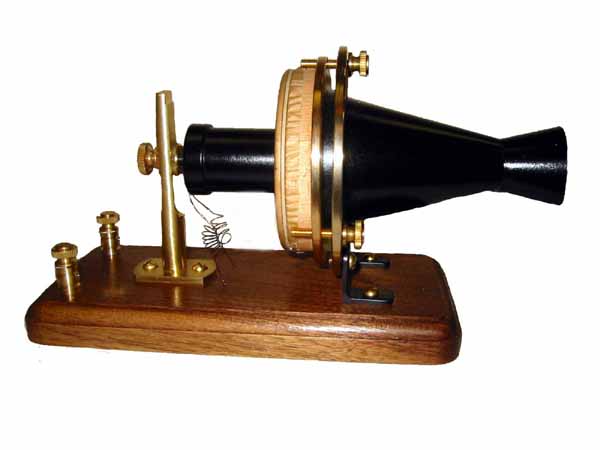 \
\ \
\
The Centennial Model is so labeled because it was first demonstrated on June 25, 1876 at the Centennial Exhibition in Philadelphia. Among those who witnessed and even participated in this event were such notables as Dom Pedro, Emperor of Brazil, Sir William Thompson (later Lord Kelvin), England’s foremost scientist, and Elisha Gray. Bell considered Gray to be his chief rival in the race to perfect a multiple-message harmonic telegraph system, a project that was now being overshadowed by Bell’s telephonic experiments.
This instrument was a more refined version of the original Gallows Model. The hinged armature was replaced with an iron disk glued directly to the parchment diaphragm, which improved the instrument’s performance. However, parchment is rather hygroscopic, and in just a few minutes of talking can absorb enough moisture from the breath to cause the material to lose its original drum-like tautness. It becomes limp. When this happens, sound quality quickly deteriorates, and the iron disk soon latches magnetically onto the electromagnet - and conversation stops. This was an inherent problem with all of the early parchment-based transmitters.
To get an idea of how well the Centennial Model performed on that sweltering June day we can look at portions of court testimony given by Sir William Thompson during a patent infringement trial in 1882. The complainant’s attorney is questioning Sir William:
Q. You were one of the
judges at the Philadelphia exhibition...?
A. Yes.
Q. ...did he [Bell] show you anything else?
A. Yes; he showed us something which he said he would hardly call
an invention, but which might ultimately become an invention.
Q. What did Bell say...?
A. He said he could show us something which would speak, and on
that occasion, in the presence of the Emperor of Brazil, and after
some troublesome adjustments, it was made to speak. I heard the
vowel “o” and “to be or not to be,” and “there’s
the rub.”
Q. And this was after troublesome adjustments and many orders
to his assistant...?
A. Yes. I felt so very much interest that I went too far and said
the thing is done. I urged Mr. Bell to go on, and before the close
of the meeting he had improved his adjustment. My friend Watson
[Prof. James C. Watson] heard it very faintly. It required very
minute attention but I am absolutely convinced that I did hear
it.
A little over a year later, the Bell Telephone Company officially opened for business.
This page was written by A. Edward Evenson, Author of the book The Telephone Patent Conspiracy of 1876 available at Amazon.com
Return to Early Telephone Instruments
OR
Return to the homepage
Interested in old telephones? Check out the Antique Telephone Collectors Association